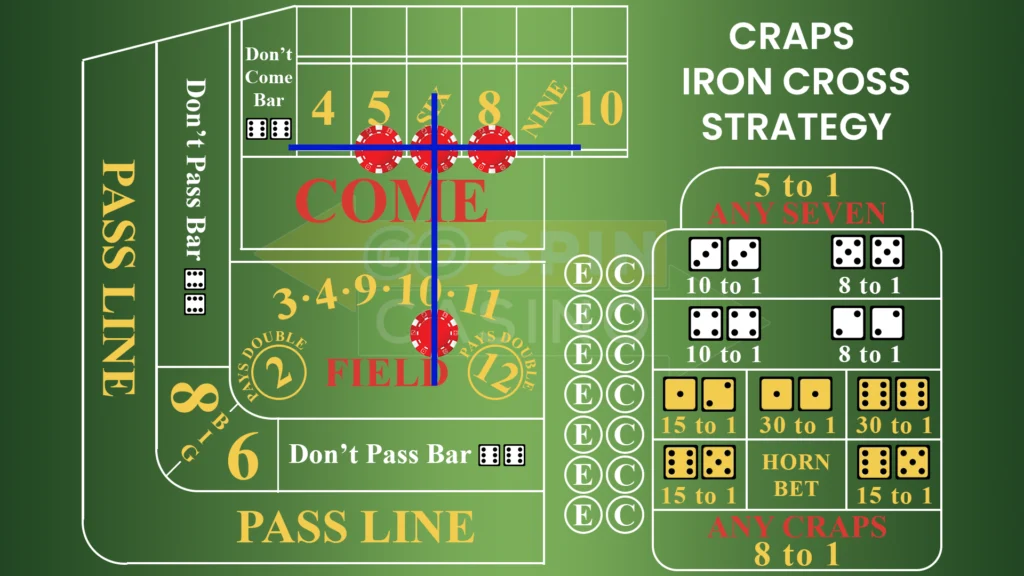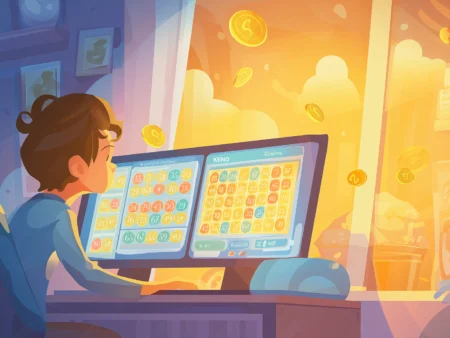What if you could place a craps bet that hits on almost every roll? That’s the promise behind the Iron Cross craps strategy, a high-action setup built to keep chips moving and players locked in. It’s tailor-made for anyone who hates waiting and wants nonstop engagement.
But here’s the twist: every win dodges just one number, the 7. And when it lands, it takes everything with it.
The Iron Cross looks like a near-constant payout machine, but its blind spot is the most dangerous number in the game. If you’re not managing your exposure or timing your bets, that false sense of safety can drain your stack fast.
So, is it a calculated way to stay active at the table, or a flashy system built on thin ice? If you’ve tested other craps betting systems and want something riskier, more aggressive, and hands-on, this one’s worth a look, just bring a sharp eye and a stop-loss.
Table of contents
- What Is the Iron Cross Craps Strategy?
- Pros and Cons of the Iron Cross Strategy
- When to Use the Iron Cross Strategy
- How to Execute the Iron Cross in a Real Game
- Alternatives to Iron Cross: Smarter Long-Term Craps Betting
- Iron Cross Craps Strategy: FAQs
- Conclusion: Should You Use the Iron Cross Strategy?
- Ready to Test the Iron Cross for Real?
What Is the Iron Cross Craps Strategy?
The Iron Cross craps strategy is built for action. It’s designed to hit on almost every roll, except the one that ends your run: the 7. If you’re the kind of player who hates sitting through dry spells and wants constant engagement, this system was made for you.

How It Works
At its core, the Iron Cross is a combo betting system that merges Place bets and a Field bet to cover nearly every outcome on the table.
You’re betting on:
- Place bets on 5, 6, and 8
- Field bet covering 2, 3, 4, 9, 10, 11, and 12
That leaves just one number uncovered: the 7. And when it shows up, which it does more than any other number, you lose everything on the felt.
Here’s what the coverage looks like in real terms:
| Number Rolled | Bet Covered | Outcome |
| 2 | Field | Win (often 2:1) |
| 3 | Field | Win |
| 4 | Field | Win |
| 5 | Place Bet | Win |
| 6 | Place Bet | Win |
| 7 | None | Lose All Bets |
| 8 | Place Bet | Win |
| 9 | Field | Win |
| 10 | Field | Win |
| 11 | Field | Win |
| 12 | Field | Win (often 2:1) |
Key takeaway: You’ll win something on almost every number, except 7. That’s the thrill… and the trap.
Why It’s Popular
So why do players keep coming back to this strategy, even knowing the risk?
- Frequent hits: You’re cashing in on most rolls. It’s the opposite of sitting back waiting for a point to resolve.
- Minimal dead rolls: With only one number killing the action, the gameplay feels constant and rewarding, until it’s not.
- Structured aggression: You’re not just tossing chips, you’re building a betting layout that gives you control, without needing deep math.
It’s a textbook example of how craps combo bets can create a smoother, more engaging ride, or at least the illusion of one.
Pros and Cons of the Iron Cross Strategy
Like any system that promises near-constant wins, the Iron Cross strategy delivers fast action, but it also exposes you to the most punishing number on the layout. It’s a high-engagement, high-risk approach that appeals to thrill-seekers but can chew through chips if you’re not careful.
Let’s be real about what works, and what doesn’t.
Pros
Hits often, especially on field-friendly tables
With only one losing number (7), you’re collecting payouts on most rolls. On tables where both 2 and 12 pay 2:1 in the field, this strategy gets a nice little edge baked in.
Built for fast-paced action
You’re active on every roll. No waiting for points. No sitting out. This keeps momentum high and energy up, ideal for short, high-intensity sessions where you’re chasing excitement, not just edge.
Simple and structured
No need to track progressions or manage complicated systems. Place your bets on 5, 6, 8, drop a chip on the Field, and you’re good. It’s easy to learn, which makes it appealing to casual players who still want a plan.
Cons
A roll of 7 wipes everything out
This is the big one. Seven shows up more than any other number in craps, and when it does, every single one of your bets is gone. You’re risking a wide spread of chips for a string of small wins and one massive gut punch.
Not built for long sessions
Iron Cross looks stable, until the math catches up. The small hits can’t keep up with the full-bet losses over a long run. If you’re trying to play for an hour on a limited bankroll, this system will wear you down.
Field bets can be deceptive
Not all field bets pay equally. Some tables only offer 2:1 on one number (either 2 or 12), or worse, pay even money across the board. That kills the value of the strategy’s most dynamic component.
Know your odds before betting, check our craps payout guide to see how different table rules can make or break your Iron Cross setup.
When to Use the Iron Cross Strategy
The Iron Cross isn’t a one-size-fits-all system. It thrives under the right conditions, and crashes hard under the wrong ones. Use it at the wrong table or with the wrong mindset, and you’re just feeding chips to the felt. But when the timing clicks, it can be one of the most engaging ways to ride a heater.
Let’s break down when to go for it, and when to walk away.
Situations Where It Performs Well
1. Field-Friendly Tables
If the table pays 2:1 on both 2 and 12, your field bet gets a major boost. That bonus payout can help smooth over the small Place bet returns and give the strategy a fighting chance over multiple rolls.
Pro tip: Always check the felt or ask the dealer. Not all field bets are created equal.
2. Hot Shooter Streaks
When the shooter’s in the zone and avoiding 7s, this strategy sings. You’ll see hit after hit, field rolls, place hits, payouts stacking. Eight or ten solid rolls isn’t uncommon, and that’s where the Iron Cross shines: high-frequency wins with little downtime.
3. Short, High-Energy Sessions
Just killing time? Looking to jump into a game for 20 minutes? This is your move. The Iron Cross gets you into action right away, no waiting for points or odds, no setup. Bet, roll, collect, repeat.
When to Avoid It
1. Cold Tables with Back-to-Back 7s
If 7s are landing often, the Iron Cross becomes a chip shredder. You’ve got no protection, and no hedge. This isn’t a “weather the storm” strategy. Either the table’s working for you or it’s draining your stack.
2. You’re Playing with a Tight Bankroll
This system requires four active bets on every roll. That means you’re risking more with each throw than in leaner systems. Trying to stretch €/$ 100? The Iron Cross might burn through that before you finish your drink.
3. Bad Field Bet Rules
If the field only pays 1:1 across the board, no 2:1 bonuses on 2 or 12, you’re playing with a dull blade. The edge you think you have disappears fast.
How to Execute the Iron Cross in a Real Game
So how do you actually play the Iron Cross craps strategy at the table?
The setup’s simple. The outcome? Not always. The real magic, or heartbreak, comes with how each roll plays out. Let’s walk through a realistic hand using common table minimums to see exactly what you’re risking… and what you might walk away with.
Your Bet Setup
- €/$ 5 on 5
- €/$ 5 on 6
- €/$ 5 on 8
- €/$ 5 on the Field
Total exposure per roll: €/$ 20
This covers everything except the 7, the one number that ends your run.
Roll Outcomes, Real Example
Roll 1: Shooter Rolls a 9
- 9 hits the Field
- You win €/$ 5 on the Field
- Place bets stay untouched
Net Profit: +€/$ 5
Roll 2: Shooter Rolls a 6
- 6 hits your Place bet
- Standard payout: €/$ 5 pays €/$ 5
- You lose the €/$ 5 Field bet
➖ Net Result: €/$ 0 (break-even)
Roll 3: Shooter Rolls a 7
- 7 hits, the worst-case scenario
- You lose all active bets: 5, 6, 8, and Field
Net Loss: -€/$ 20
Total for This Sequence:
| Roll | Result |
| 1 | +€/$ 5 |
| 2 | €/$ 0 |
| 3 | -€/$ 20 |
Net Result: -€/$ 15
Key Takeaway
The Iron Cross feels like you’re constantly collecting, until that inevitable 7 shows up and wipes out your stack in one shot. That’s why this strategy works best in short bursts, not marathon sessions.
The question with this system isn’t if the 7 shows up, it’s when. Plan your session accordingly.
Alternatives to Iron Cross: Smarter Long-Term Craps Betting
The Iron Cross craps strategy has its moments, but if you’re aiming for consistency over chaos, there are sharper ways to play. Smart craps betting isn’t about dodging every loss (that’s a myth); it’s about minimizing house edge and getting the most value from every dollar on the felt.
Why Place Bets on 6 & 8 Alone Might Be Better
The 6 and 8 are the most frequently rolled numbers in craps outside of 7. That makes them the sweet spot for players who want long-term efficiency over flashy win rates.
Here’s why they outperform Iron Cross in the long game:
- Lowest house edge on Place bets, around 1.52%
- Strong payout structure, a €/$ 6 bet pays €/$ 7
- Lower exposure, only betting two numbers instead of four
Let’s break it down:
You place €/$ 6 each on 6 and 8 → €/$ 12 total risk per roll
With Iron Cross, you’re risking €/$ 20 per roll
Over time, fewer bets with better odds = more staying power
This system may feel slower, but it delivers more consistent results, with fewer gut-punch losses.
Other Systems Worth Exploring
If you’re ready to move past gimmicks and start playing like a strategist, these systems offer structure and upside:
- 3 Point Molly – A staple for a reason. Combines Pass Line, Odds, and Place bets for balanced, aggressive play.
- Don’t Pass / Lay Bet systems – The contrarian’s game. Less flashy, lower variance, and surprisingly effective.
- 6/8 Strategy – Streamlined, efficient, and focused entirely on the two best non-7 numbers. Great for grinders.
Want to level up your betting IQ? Explore more advanced betting systems that balance action and advantage.
Iron Cross Craps Strategy: FAQs
It can be, in short sessions and on the right tables. The strategy delivers frequent hits, which feels great in the moment, but one roll of a 7 wipes everything. If you’re chasing action, it’s fun. If you’re chasing profit, it’s limited.
Place bets on 5, 6, and 8. Add a Field bet to cover 2, 3, 4, 9, 10, 11, and 12. That covers every number except 7. You win on almost everything, until a 7 lands and clears the table.
In terms of long-term edge, the most profitable approaches are Pass Line with full odds, Don’t Pass with lays, or Place betting on 6 and 8. Iron Cross isn’t designed for profit, it’s built for action and engagement.
Mathematically, it’s the Pass Line with full odds. There’s no house edge on the odds portion, and the overall house edge stays under 1%. Don’t Pass bettors have similar or better odds, but fewer fans.
Only if the table charges no commission on buy bets, which is rare. Most of the time, you’re better off placing 6 and 8 instead of buying them. The payout is cleaner, and the house edge is lower.
Conclusion: Should You Use the Iron Cross Strategy?
The Iron Cross craps strategy is like a flashy sports car, thrilling to drive, but not built for long hauls. It’s fast, aggressive, and when the dice are hot, it can feel like you’re printing chips. But that rush can vanish in a heartbeat the moment a 7 shows up.
If your goal is bankroll efficiency, consistency, or low-variance grind, you’re better off with systems like Place betting on 6 and 8 or the 3 Point Molly, strategies built for staying power.
But if you’re chasing short bursts of action, fast-paced wins, and a bit of calculated chaos, the Iron Cross absolutely delivers, just make sure you’re managing risk and reading the table.
Ready to Test the Iron Cross for Real?
Want to put the Iron Cross to work in a real game, or try it out risk-free?
Explore our top-rated online craps sites and start playing smarter today.
Whether you’re rolling with bonus funds or betting live, Go Spin Casino connects you to trusted platforms that deliver real action, and real payouts.












































